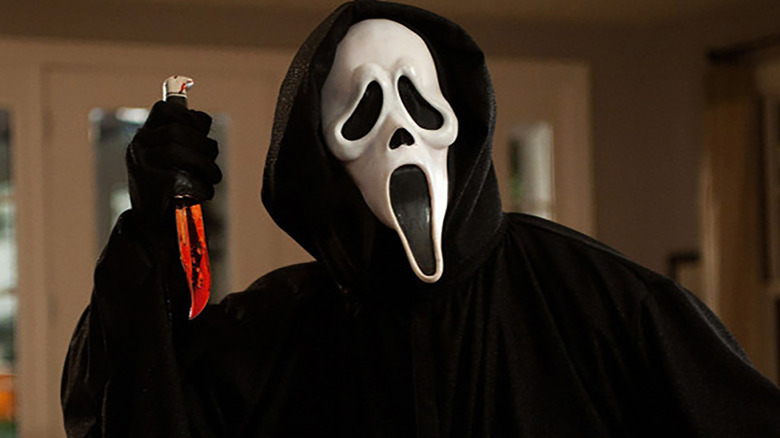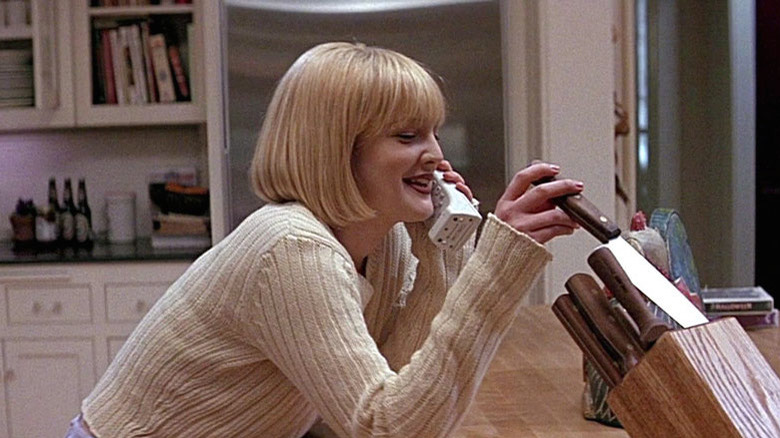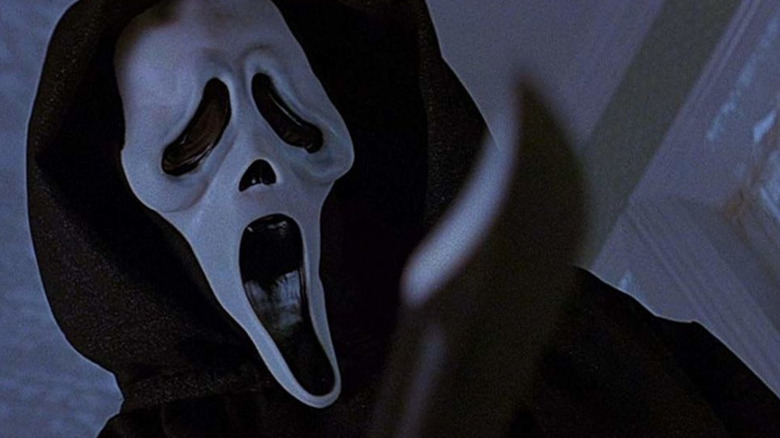
Wes Craven's iconic slasher "Scream" just turned 25, making now the perfect moment to celebrate this genre redefining classic. So many elements came together to make this meta horror flick the masterpiece it is — from the legendary Wes Craven signing on to direct, to finding just the right mask to terrify the masses. Make no mistake, a huge part of this film's legacy is birthing one of the most enduring masks of horror history. Each knife-wielding iteration of Ghostface haunts Sidney Prescott (Neve Campbell) from behind the iconic mask: a thin, white rubber disguise that's somehow still terrifying. But did you know that Ghostface was very nearly changed once the studio took a look?
The Ghostface mask existed long before "Scream" entered production, sold in costume stores as a typical Halloween mask. Now, thanks to the legacy of the movie, that mask holds extra weight — no one can look at it without thinking of Sidney's deadly stalker. Even those who haven't seen the films are familiar with the mask as "Scream" iconography — that's the power of the movies, after all. The franchise transformed the cheap white plastic into a terrifying symbol — anyone could be hiding behind it. Its endless dark eyes are horrible, ghostly, sad, threatening, and almost apologetic all at once. Whoever dons the costume in the films becomes an otherworldly kind of monster, appearing and disappearing with ease — and somehow, they're distinctly human. They had to stroll into a costume store, after all, to get their hands on the disguise. It's hard to imagine "Scream" with any other mask on the cover, but in the early days of production, it was a real possibility.
The Legend Of Ghostface

Apparently, Dimension Films didn't think the mask was scary enough. This story has been floating around for a while now, but in an incredible oral history of "Scream" for The Hollywood Reporter, crew members get into the weeds of exactly what went down that day. The now famous opening scene, which introduces the Ghostface mask and sees the killer chase down Drew Barrymore's Casey Becker, wasn't popular with the Weinstein brothers, the co-founders of Dimension Films. Franchise writer Kevin Willamson set the scene, saying:
"We were sitting in the parking lot of the grocery store and we were filming the news footage of Liev Schreiber walking out and being put into a car and ushered away. Wes got the phone call from the studio and I was sitting behind him in my chair and I just saw his back slump. He just started sliding down the chair. They didn't think anything about it was good. They didn't understand the lack of footage and they didn't see his vision for that sequence at all."
Dimension was displeased with the dailies, and most notably, with the mask. According to producer Cathy Konrad:
"The controversy, which is pretty notorious, had a lot to do with the ghost mask. They felt like things looked flat. They felt like things were unexciting, that the mask wasn't scary. I was getting calls early in the morning that were very demanding about ensuring that things change."
Her fellow producer Marianne Maddalena added that the pressure was intense because it came directly from Bob Weinsetin, and the entire crew was aware. She added "We were traumatized because we were working really hard and we thought we were doing great work." The whole process was especially frustrating because it was based on dailies — the unedited footage. As Konrad said, "you cannot see these movies for what they're going to become without the tension being built into the cutting."
How Ghostface Survived The Weinsteins

Perhaps it's not shocking to hear that "Scream" was threatened by the involvement of the Weinsteins. After all, Harvey Weinstein had a reputation — not just for his monstrous sexual assault charges, but for mutilating films in editing. No one seems to know who first coined the phrase, but the Dimension co-founder was often referred to as "Harvey Scissorhands." Thankfully, in this case, everything eventually worked out for the better once the crew proved the executives wrong. Konrad said:
They sent an executive out very early on. Myself, Marianne and Stuart Besser, who was the line producer, received a call very late in the evening and it went like this: "Hello, Cathy, do you like scary movies?" It was Wes and he was asking for us to come to his hotel room. We were at the DoubleTree in Santa Rosa. The executive from Dimension was there, Cary Granat. What was being asked of us was to shoot everything that we'd already shot with several other masks so that Bob could decide which one he liked best. No, nobody's doing that. So the idea was presented, can we cut together what we have shot and can we prove to you it's effective? We were given that courtesy period and Patrick Lussier, who was the editor, worked very quickly and nimbly. You cannot see these movies for what they're going to become without the tension being built into the cutting.
Maddalena added:
After we showed Bob the cut sequence of the opening scene, he said, "What do I know about dailies? Keep going."
According to Lussier, once that was sorted and confidence restored, "suddenly there was money for an orchestra, there was money for all sorts of things." In the end, "Scream" became all it was meant to be and lives on 25 years later. And in a matter of months, the saga will continue with the fifth movie in the franchise — which we already have a trailer for.
Read this next: The 15 Best '90s Horror Movies Ranked
The post How Scream's Editor Saved the Movie From the Weinsteins appeared first on /Film.
from /Film https://ift.tt/3nFCfhE
via IFTTT
Comments
Post a Comment